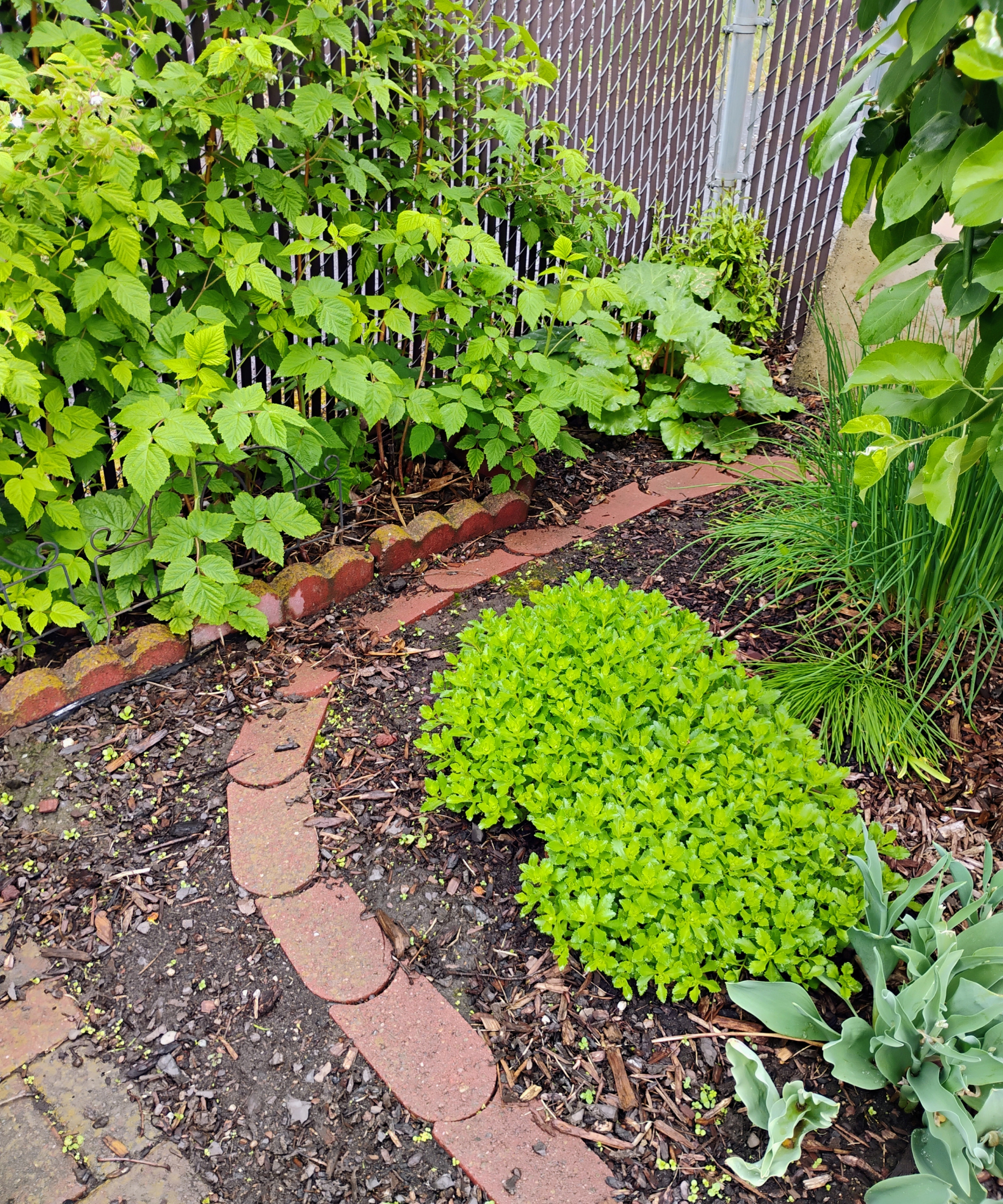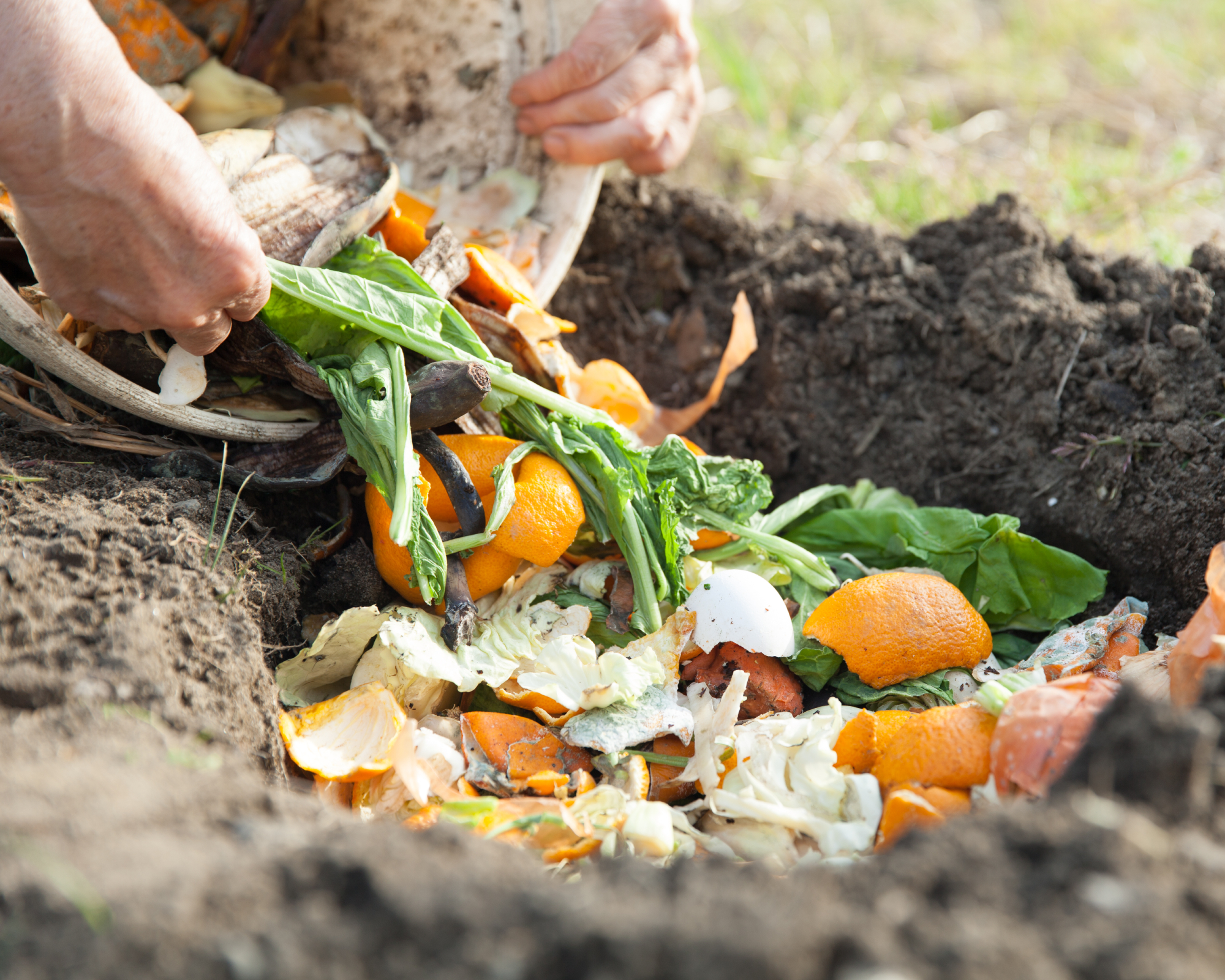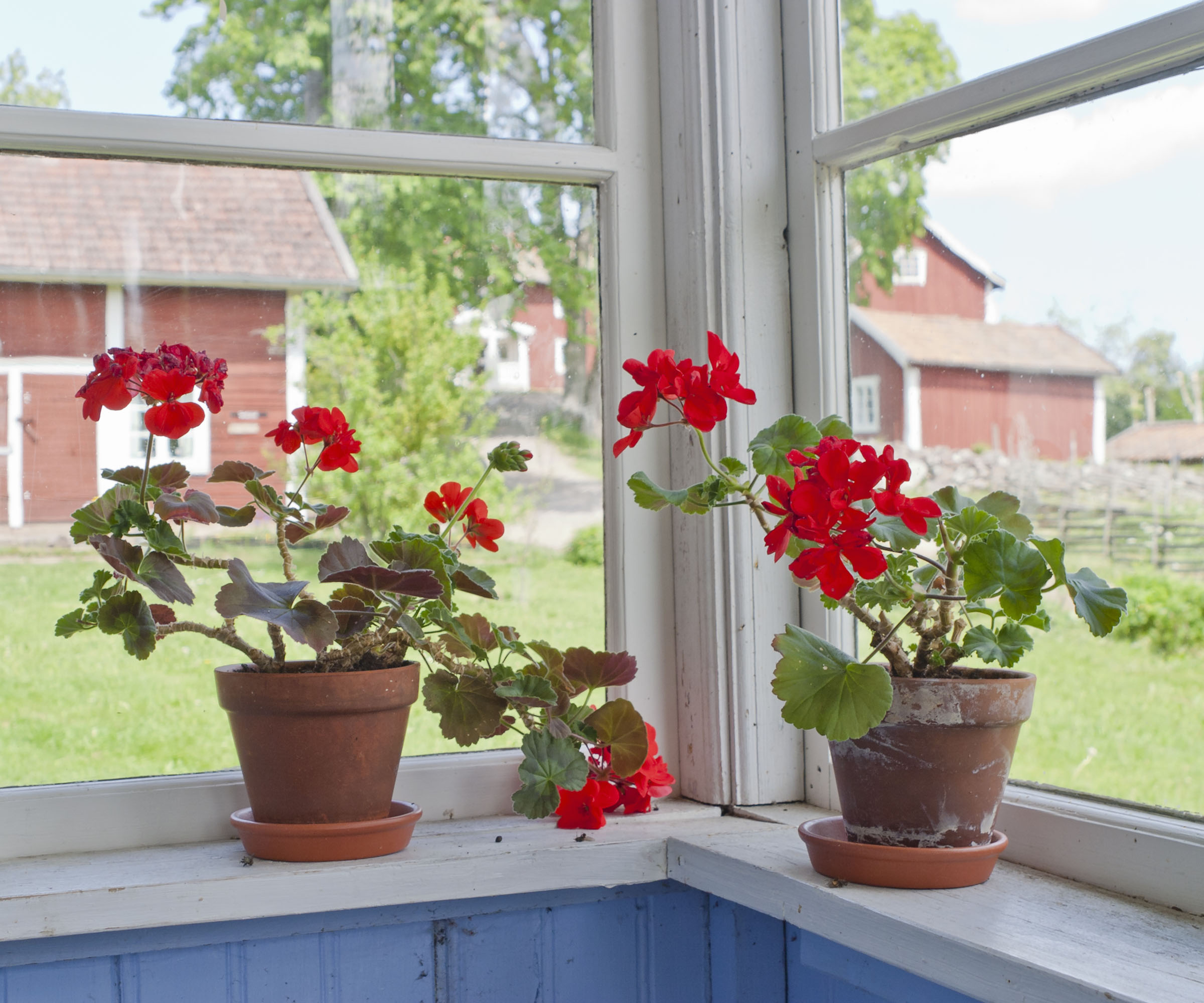Table of Contents
Introduction
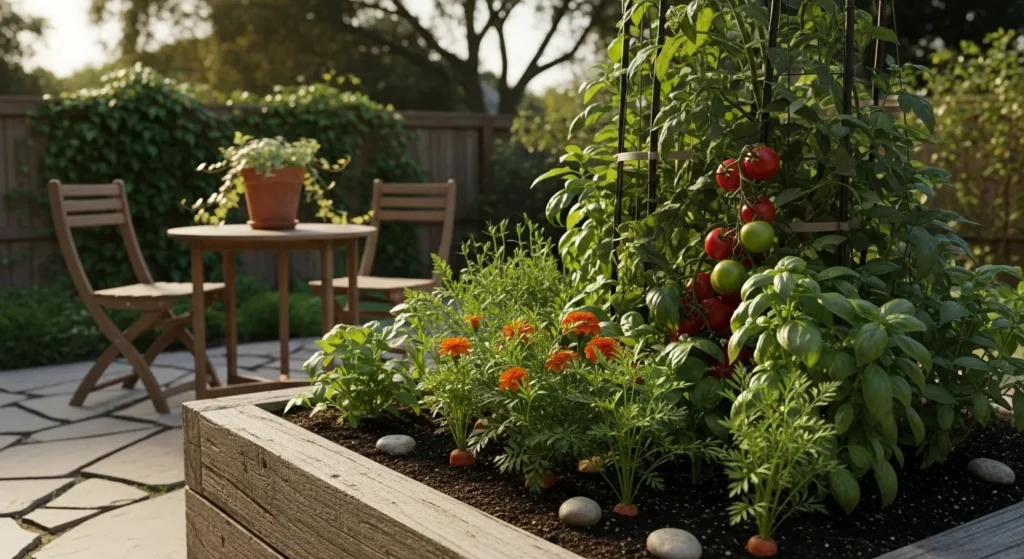
If you’ve ever wished your raised bed could practically take care of itself—producing more vegetables, attracting pollinators, and keeping pests at bay—then companion planting for raised beds is your secret weapon. This time-tested gardening method pairs plants that help each other thrive, making the most of your limited space.
In this guide, we’ll walk through a month-by-month planting calendar designed for small-space gardeners. Whether you’re working with a 2’x4’ box on your patio or a 4’x8’ bed in your backyard, you’ll learn exactly what to plant, which companions to pair, and how to keep your soil healthy all year long.
By the end, you’ll have a seasonal blueprint for raised bed veg gardening that boosts yields, prevents pests naturally, and makes gardening more enjoyable—without needing a huge plot of land.
How Companion Planting Helps Raised Beds
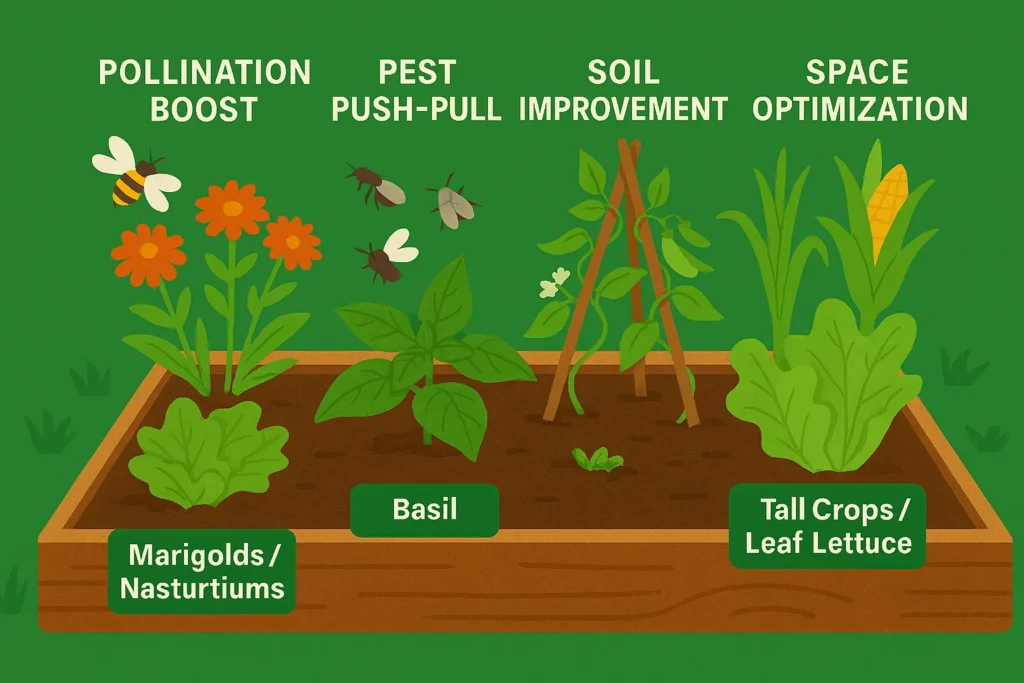
Companion planting is more than just putting friendly plants together—it’s a strategic way to maximize productivity in a small footprint.
- Pollination Boost 🐝 — Flowers like marigolds, nasturtiums, and calendula draw pollinators, increasing fruit set for crops like tomatoes and cucumbers (Eartheasy guide).
- Pest Push–Pull 🐛 — Strong-scented herbs (basil, rosemary, chives) repel pests, while trap crops (radishes, nasturtiums) lure them away from your main harvest (The Garden Beds).
- Soil Improvement 🌱 — Legumes like beans and peas fix nitrogen, feeding heavy feeders like corn and brassicas.
- Space Optimization 📏 — Tall crops provide shade for greens, while ground covers suppress weeds and keep soil moist.
Quick Rules for Raised-Bed Companion Planting
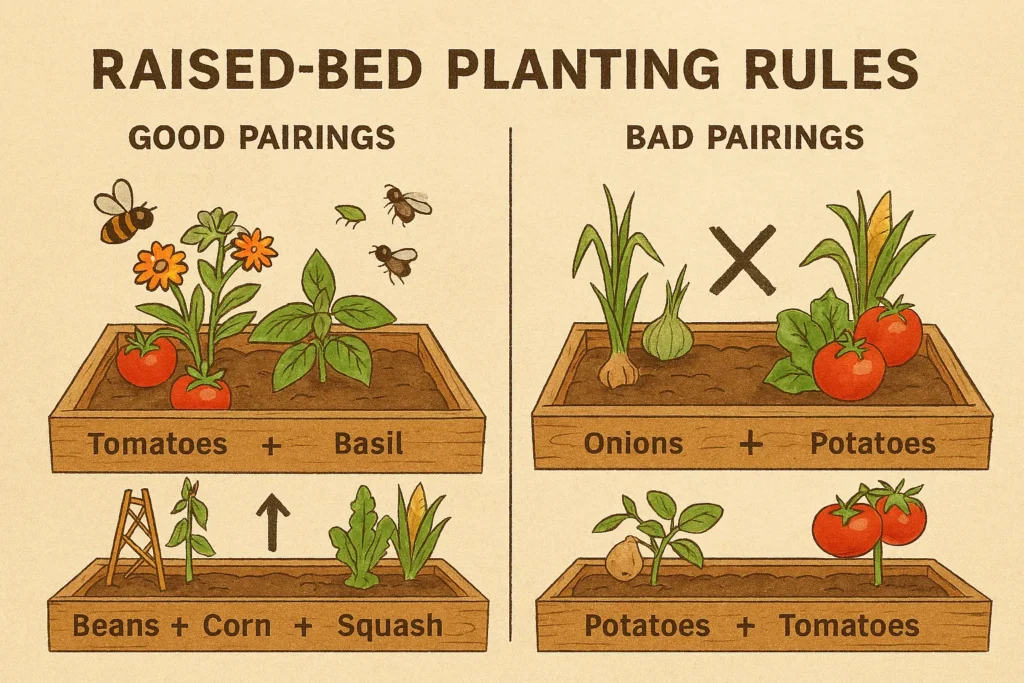
Plant Families to Avoid Together
Some plants compete for nutrients or attract the same pests:
- Onions + Beans — Onions stunt bean growth.
- Tomatoes + Corn — Both attract corn earworm/tomato fruitworm.
- Potatoes + Tomatoes — Increase risk of blight.
Timing & Crop Rotation Basics
- Rotate plant families each season to prevent soil-borne diseases (Farmer Flints).
- Follow heavy feeders (tomatoes, corn) with nitrogen-fixers (beans, peas).
- Stagger planting to keep beds productive year-round.
Month-by-Month Companion Planting Calendar for Raised Beds
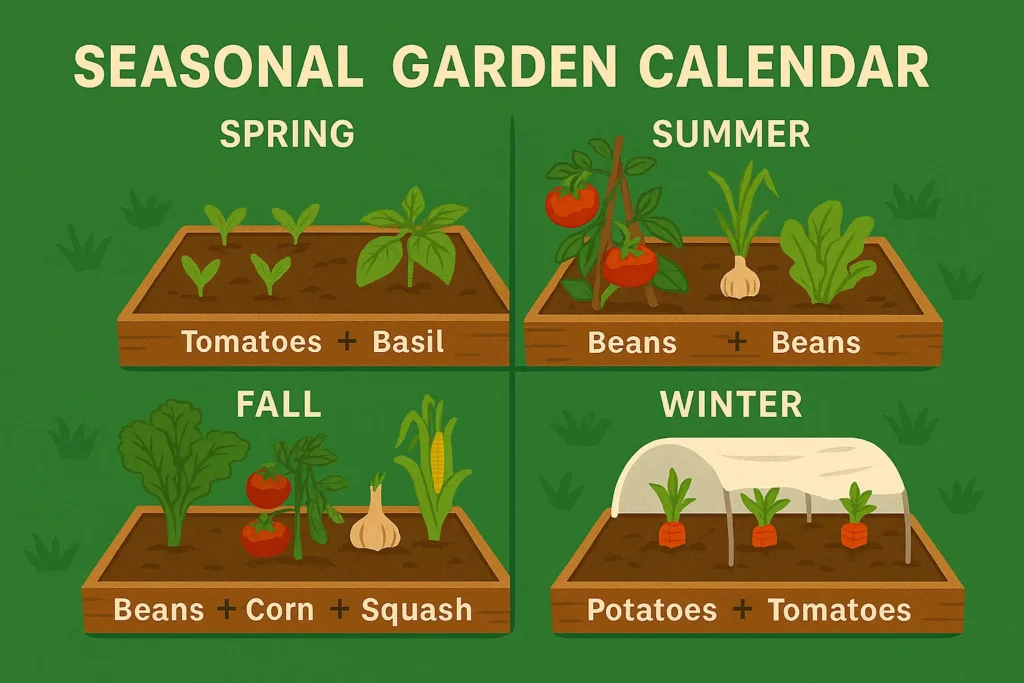
This is the core of your raised bed veg gardening plan — a month-by-month guide that tells you exactly what to plant, which companions to pair, and what quick maintenance tasks will keep your garden thriving.
It’s designed for small-space gardeners using raised beds, but you can adapt it to your climate by shifting the months forward or backward by 4–6 weeks based on your frost dates.
For layout inspiration, see the Beginner’s Guide to DIY Raised Garden Beds and the Companion Planting Chart for Raised Beds – Farmer Flints.
January – Planning & Early Starts Indoors
What to Plant:
- Indoors: Tomatoes, peppers, eggplants, onions, leeks.
- Outdoors (mild climates): Spinach, kale, radishes, broad beans.
Top Companion Pairings:
- Onions + Carrots — Onions deter carrot fly; carrots loosen soil for onions.
- Kale + Dill — Dill attracts hoverflies and ladybugs that eat aphids.
Tasks:
- Inspect overwintering mulch for slugs or earwigs.
- Add 2–3 cm of compost to beds (Safe Materials for Raised Beds).
- Sketch your square foot gardening layout (Dian Farmer’s layout tips).
February – Seed Starting & Soil Prep
What to Plant:
- Indoors: Lettuce, cabbage, broccoli, cauliflower.
- Outdoors (mild): Peas, spinach, beets, turnips.
Top Companion Pairings:
- Peas + Carrots + Radishes — Peas fix nitrogen, carrots benefit from loosened soil, radishes mature quickly.
- Broccoli + Nasturtium — Nasturtiums lure cabbage moths away from brassicas.
Tasks:
- Lightly turn soil to aerate without harming worms.
- Add well-rotted manure for heavy feeders.
- Check for early aphid colonies (Organic pest control in raised beds – Eartheasy).
March – Cool-Season Planting Begins
What to Plant:
- Direct Sow: Lettuce, spinach, peas, carrots, radishes, beets.
- Transplant: Early cabbage, broccoli, onions.
Top Companion Pairings:
- Lettuce + Chives — Chives repel aphids and improve lettuce flavor.
- Carrots + Onions — Classic pest deterrent combo.
Tasks:
- Install row covers for flea beetles.
- Mulch early crops to retain moisture.
- Side-dress peas with compost mid-month.
April – Warm-Season Crops Start Indoors
What to Plant:
- Indoors: Tomatoes, peppers, basil.
- Outdoors: Potatoes, onions, kale, chard, lettuce, peas.
Top Companion Pairings:
- Tomato + Basil + Marigold — Basil repels whiteflies, marigolds deter nematodes.
- Spinach + Strawberries — Strawberries shade spinach roots; spinach suppresses weeds.
Tasks:
- Watch for aphids on brassicas — plant nasturtiums nearby.
- Add compost tea to boost soil microbes.
- Thin seedlings to avoid overcrowding.
May – Transition to Warm-Season Planting
What to Plant:
- Direct Sow: Beans, corn, cucumbers, squash, melons.
- Transplant: Tomatoes, peppers, eggplants, basil.
Top Companion Pairings:
- Beans + Corn + Squash (Three Sisters) — Corn supports beans, beans fix nitrogen, squash shades soil.
- Cucumbers + Dill — Dill attracts predatory wasps that eat cucumber beetles.
Tasks:
- Mulch heavily around heat-loving crops.
- Check cucumber leaves for beetles.
- Stake tomatoes early.
June – Peak Growth for Warm Crops
What to Plant:
- Succession Sow: Lettuce, radishes, bush beans.
- Direct Sow: Okra, cucumbers, zucchini.
Top Companion Pairings:
- Peppers + Basil — Basil repels thrips and improves pepper flavor.
- Carrots + Tomatoes — Tomatoes shade carrots; carrots loosen soil.
Tasks:
- Handpick hornworms from tomatoes.
- Side-dress heavy feeders with compost.
- Keep soil evenly moist to prevent blossom end rot.
July – Maintenance & Succession Planting
What to Plant:
- Succession Sow: Beans, beets, carrots, lettuce (heat-tolerant).
- Fall Crops (start indoors): Broccoli, cabbage, kale.
Top Companion Pairings:
- Cabbage + Chamomile — Chamomile improves cabbage flavor and attracts beneficial insects.
- Lettuce + Radishes — Radishes mature quickly, leaving space for lettuce.
Tasks:
- Watch for spider mites in hot weather.
- Mulch to keep soil cool.
- Remove diseased leaves promptly.
August – Start Fall Garden
What to Plant:
- Direct Sow: Spinach, kale, turnips, radishes.
- Transplant: Broccoli, cauliflower, cabbage.
Top Companion Pairings:
- Spinach + Garlic — Garlic repels leaf miners.
- Beets + Onions — Onions deter pests from beets.
Tasks:
- Check brassicas for cabbage worms.
- Add compost before planting fall crops.
- Keep beds watered during heat.
September – Cool-Season Crops Take Over
What to Plant:
- Direct Sow: Lettuce, spinach, radishes, Asian greens.
- Transplant: Kale, chard.
Top Companion Pairings:
- Lettuce + Garlic Chives — Chives deter aphids.
- Radish + Spinach — Radishes loosen soil for spinach roots.
Tasks:
- Mulch to protect seedlings from temperature swings.
- Remove summer crop debris.
- Side-dress fall crops with compost.
October – Final Plantings Before Frost
What to Plant:
- Direct Sow: Garlic, shallots, and overwintering onions.
- Transplant: Late kale, spinach (mild climates).
Top Companion Pairings:
- Garlic + Carrots — Garlic deters carrot fly.
- Kale + Mint (in pots) — Mint repels cabbage moths.
Tasks:
- Cover beds with row covers or cold frames.
- Add leaf mulch to insulate soil.
- Plant cover crops like clover or vetch.
November – Protect & Maintain
What to Plant:
- Mild Climates: Spinach, lettuce, radishes.
- Cold Climates: Focus on soil building.
Top Companion Pairings:
- Spinach + Strawberries — Strawberries protect spinach roots from frost.
- Onions + Beets — Onions deter pests from beets.
Tasks:
- Check for vole or mouse activity under mulch.
- Add compost to empty beds.
- Keep row covers secure.
December – Rest & Reflect
What to Plant:
- Indoors: Microgreens, basil, parsley.
- Outdoors (mild): Garlic, broad beans.
Top Companion Pairings:
- Basil + Tomatoes (indoors) — Basil deters indoor pests.
- Parsley + Chives — Both deter aphids indoors.
Tasks:
- Clean and oil garden tools.
- Review garden notes for next year’s crop rotation.
- Order seeds early (List of Best Vegetables for Raised Beds).
Top 12 Companion Pairings for Raised Beds
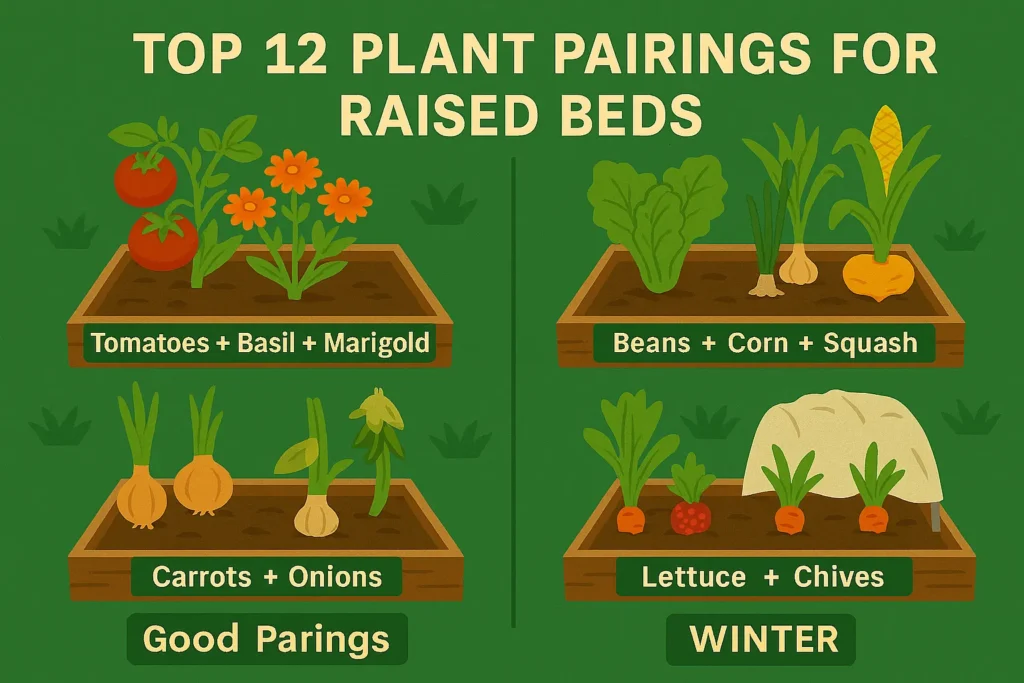
- Tomato + Basil + Marigold
- Beans + Corn + Squash (Three Sisters)
- Carrots + Onions
- Lettuce + Chives
- Cabbage + Nasturtium
- Spinach + Strawberries
- Peppers + Basil
- Cucumbers + Dill
- Beets + Garlic
- Kale + Mint (in pots nearby)
- Radish + Spinach
- Broccoli + Chamomile
Common Pest Problems & Companion-Based Fixes
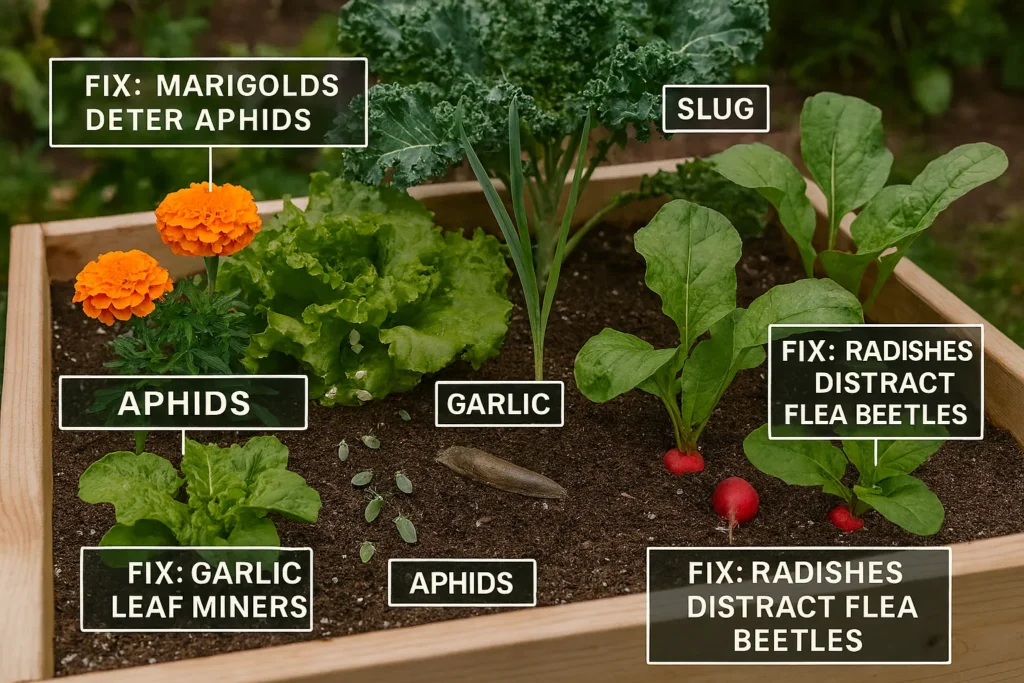
- Aphids — Plant nasturtiums, calendula; spray with soapy water (Organic pest control in raised beds).
- Slugs — Use beer traps; plant chives and garlic nearby.
- Flea Beetles — Grow radishes as sacrificial crops.
- Blight — Avoid planting tomatoes and potatoes together; rotate crops yearly.
DIY Soil Amendment & Planting Mix Recipes
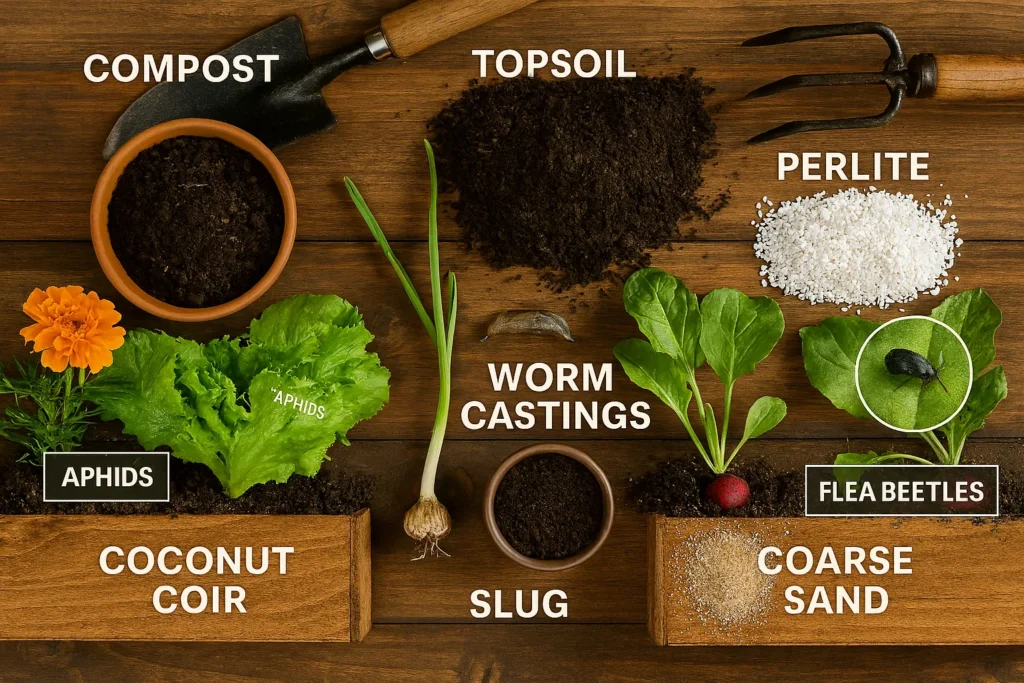
(Also see Safe Materials for Raised Beds)
Budget Mix:
- 40% topsoil
- 40% compost
- 20% coarse sand
Premium Mix:
- 50% high-quality compost
- 30% coconut coir
- 20% perlite + worm castings
More ideas: 7 homemade soil amendment recipes
Sample Planting Diagrams for Raised Beds
A good planting diagram helps you visualize companion planting before you put a single seed in the soil. Below are two example layouts — one for a compact 2’x4’ bed and one for a versatile 4’x4’ bed — showing how to group plants for maximum yield, pest control, and soil health.
For more inspiration, see the Garden Plans for 4×4 Beds – Heart’s Content Farmhouse and the Raised Bed Garden Plan – Must Love Lists.
2’x4’ Raised Bed Layout – Small but Mighty
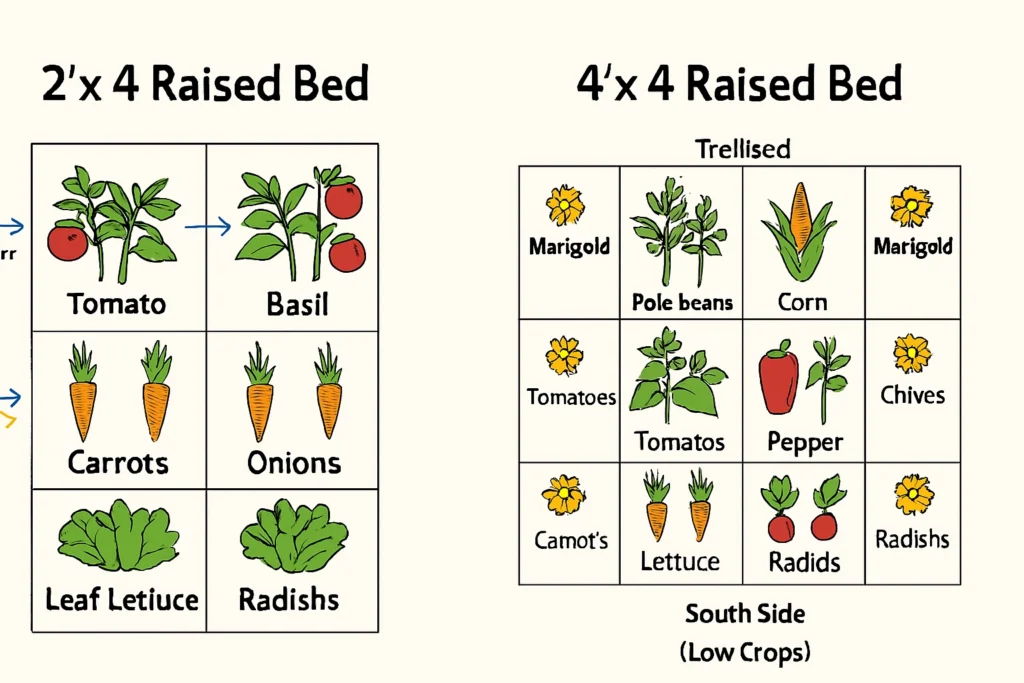
This layout is perfect for patios, balconies, or narrow garden spaces.
North Side (Back Row – Tall Crops)
- 2 Tomato plants (staked or caged) in the back corners.
- Basil planted at the base of each tomato to repel pests and improve flavor.
- Marigolds tucked between tomatoes for nematode and aphid deterrence.
Middle Rows (Medium Height Crops)
- Carrots in one row — benefit from tomato shade.
- Onions in the next row — deter carrot fly and other pests.
Front Row (South Side – Low Crops)
- Leaf lettuce for quick harvests.
- Radishes are interplanted with lettuce to loosen soil.
📌 Visual Reference: See a similar compact layout in the Companion Vegetable Garden Layout – The Old Farmer’s Almanac.
4’x4’ Raised Bed Layout – Balanced & Productive
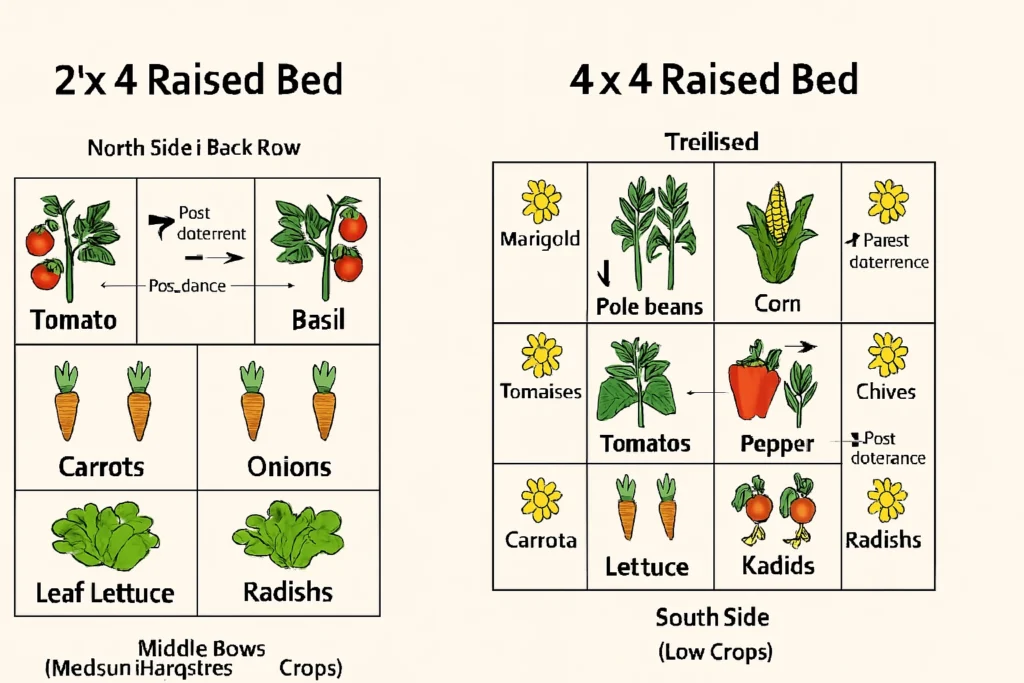
This layout uses the square foot gardening method to maximize diversity and minimize pest problems.
Corners
- Marigolds in all four corners to attract pollinators and deter pests.
North Side (Tall Crops)
- Trellised pole beans in the back row for vertical growth.
- Corn in the center back squares to support beans (Three Sisters method).
Center Squares
- Tomatoes with basil and onions around them for pest control.
- Peppers paired with chives to deter aphids.
South Side (Low Crops)
- Carrots and lettuce for quick, successive harvests.
- Radishes are interplanted for soil aeration.
📌 Visual Reference: Check out the Easy 4×4 Summer Garden – Bonnie Plants and the 4×4 Sample Garden Plans – Heart’s Content Farmhouse for illustrated examples.
Why These Layouts Work
Succession planting keeps the bed productive all season.
Height layering ensures tall plants don’t shade out sun-loving crops.
Companion pairings like tomato + basil + marigold or beans + corn + squash naturally deter pests and improve yields.
Frequently Asked Questions – Companion Planting for Raised Beds
1. What is companion planting and why is it important for raised beds?
Companion planting is the practice of growing certain plants together so they benefit each other — by deterring pests, improving soil health, or boosting yields. In raised beds, where space is limited, it’s especially valuable because it helps you maximize productivity in every square foot. Learn more in our Beginner’s Guide to DIY Raised Garden Beds and the Eartheasy Companion Planting Guide.
2. How do I know which plants grow well together?
Some pairings are classics — like tomatoes + basil + marigold or beans + corn + squash — because they’ve been proven to work over generations. You can follow our Top 12 Companion Pairings for Raised Beds in this guide, or check the Farmer Flints Companion Planting Chart for more combinations.
3. Can I use companion planting with square foot gardening?
Absolutely. In fact, square foot gardening and companion planting work beautifully together. You simply assign each square foot to a compatible plant or plant group. This maximizes yields and keeps pests guessing. For layout ideas, see Beginner’s Guide to DIY Raised Garden Beds and Dian Farmer’s Layout Tips.
4. Do I need to rotate crops in raised beds?
Yes — even in raised beds, crop rotation helps prevent soil-borne diseases and nutrient depletion. Rotate plant families each season (e.g., don’t plant tomatoes in the same spot two years in a row). Our Month-by-Month Calendar in this post shows how to stagger crops, and Safe Materials for Raised Beds explains how to keep your soil healthy long-term.
5. What are the worst plant combinations to avoid?
Some plants compete for nutrients or attract the same pests. Avoid:
- Onions + Beans — Onions stunt bean growth.
- Tomatoes + Corn — Both attract corn earworm/tomato fruitworm.
- Potatoes + Tomatoes — Increases blight risk. For a full list, see The Garden Beds Companion Planting Ideas.
6. How do I handle pests without chemicals?
Use companion plants that repel or distract pests — like nasturtiums for aphids, garlic for leaf miners, or chives for slugs. Combine this with physical barriers like row covers and organic sprays. See our Common Pest Problems & Companion-Based Fixes section above and Eartheasy’s Organic Pest Control Guide.
7. Can I grow herbs and flowers in my raised bed with vegetables?
Yes — and you should. Herbs like basil, dill, and chives deter pests and improve flavor, while flowers like marigolds and calendula attract pollinators. This creates a balanced mini-ecosystem in your raised bed.
8. How do I prepare soil for companion planting in raised beds?
Start with a nutrient-rich, well-draining mix. A good base is 40% topsoil, 40% compost, 20% coarse sand for budget builds, or our premium mix with compost, coconut coir, and perlite. Full recipes are in our DIY Soil Amendment & Planting Mix Recipes section and Safe Materials for Raised Beds.
9. How often should I add compost or fertilizer?
Light feeders (like lettuce) may only need compost once a season, while heavy feeders (like tomatoes and corn) benefit from a mid-season side-dressing. In raised beds, nutrients wash out faster, so check soil health regularly.
10. Can I companion plant year-round?
Yes — our Month-by-Month Calendar shows how to adapt companion planting for every season. Even in winter, you can grow cold-hardy greens outdoors in mild climates or start seedlings indoors for spring.
Conclusion + CTA
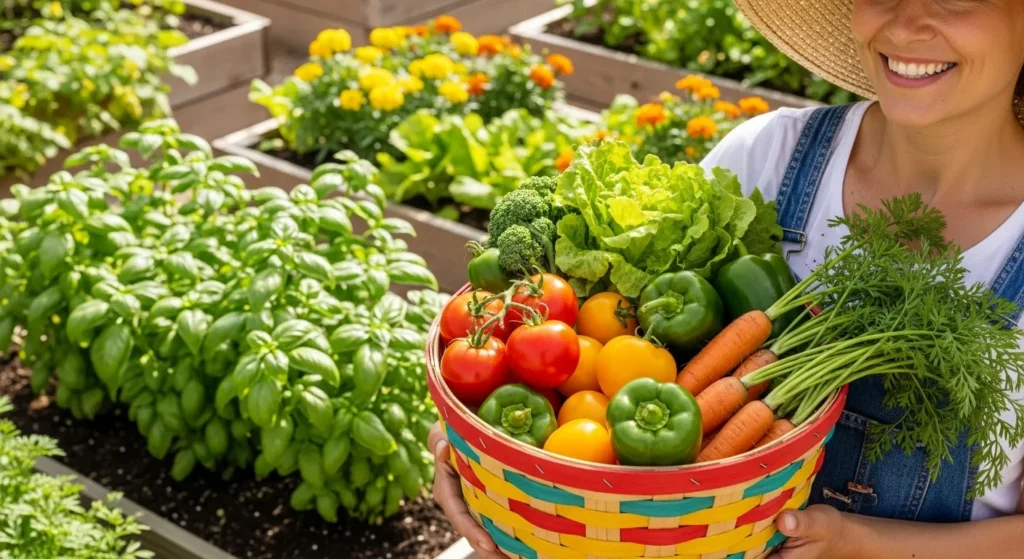
Companion planting in raised beds isn’t just about saving space—it’s about creating a living ecosystem that works with nature, not against it. With this month-by-month guide, you can enjoy healthier plants, fewer pests, and bigger harvests.
📥 Download your free printable companion planting calendar and keep it by your garden for quick reference.

